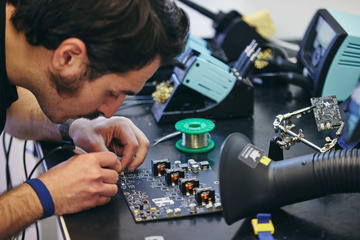BRILL BY NAME AND NATURE

BRILL BY NAME AND NATURE
A University derived start-up, Brill Power, is making waves in the critical area of battery management
Published: 11 June 2024
Author: Richard Lofthouse
Share this article

Started in 2016, Brill Power is brilliant (obviously!) but the name also references the village which is so familiar to Oxford students past and present who happen to cycle – you go out in the broad direction of Bicester and Brill is a village atop an outcrop of clay serving up a nasty little climb…
‘We needed a name and Adrien came up with Brill – we all cycled there a lot as DPhil students in the Department of Engineering,’ recalls Founder and CEO Dr Christoph Birkl (Pembroke, 2012 - Shown Right).
He’s referring to Dr Adrien Bizeray (Kellogg, 2012) today Chief Data Scientist for a company that raised $10.5m in 2022 towards their goal of making batteries smarter, cleaner, safer and longer-lasting as a critical element of the shift to zero emission energy.
The other co-founders are Dr Damien Frost (Jesus, 2013), now the Chief Technology Officer, and MBA holder Carolyn Hicks, who is Chief Financial Officer – both Canadian and Carolyn probably faster on a bike as a two times Ironman finisher. Some of Brill Power’s core IP is based on work Damien did during his DPhil in Oxford’s Engineering Science Department, supervised by Professor David Howey, academic co-founder of the company.
Their story shows you how quickly the world is changing towards electrification, but also how complex the broader scope of that monumental technology change actually is.
Christoph begins by showing me a test module which yokes together multiple battery cells in an array, much as would be the case in any car battery or static storage module for commercial or utility purposes.

In practice, every ‘battery’ comprises many cells but they don’t all age in exactly the same way, he explains. Some degrade more quickly than others. If there is no insight into the dynamic, the danger is that the whole battery pack is prematurely retired because of a single failing cell, a weakest link in a chain scenario. This can represent enormous sums of money in a utility or commercial setting where a really huge battery is required. Fear of battery degradation is also holding back the adoption of electric vehicles by consumers, according to recent surveys.
What Brill Power has done is build a Battery Management System that actively manages the power, isolating the weaker cells from the stronger ones and actively navigating the variability as the battery ages, realising 12-60% additional lifetime, while increasing storage capacity by up to 49 per cent for aged batteries.
‘With a conventional Battery Management System, all cells in a battery are exposed to the same electric current, meaning that no more energy can be extracted from a battery once the weakest cell is discharged. Our product offers what is referred to as active loading, which can access all of the energy in a battery.’
In a commercial setting, the uncertain life span of batteries is normally addressed by deliberately ordering batteries oversized by as much as 50% to actual needs, or by expanding them over time, based on a guesstimate of likely degradation – both solutions are a bit hit and miss and very expensive.
Brill Power has just started shipping its latest product to a battery system developer in Italy, where it will power a second life energy storage system used for commercial and industrial applications. As the order book is growing, the company is in the process of securing a manufacturing agreement with a major German electronics manufacturer to meet demand.
Walking me into another experimental room within the building on Hythe Bridge Street that used to be a night club, now the perfectly adapted HQ for Brill Power (non-conductive floor, big doors for loading and deliveries, but ‘not the expensive wet lab set up that we don’t actually need’) Christoph shows me another battery that looks like any other but is actually a sodium ion chemistry.
That is relevant in 2024 in ways that were completely unexpected when Brill Power was founded nine years ago.
When Tesla got started two decades ago the broad consumer assumption, at least in wealthy states, was that electric cars needed bigger and better batteries for higher range. That remains true yet seen globally not every car races down a motorway on long distance commutes. In fact most do not. Meanwhile, national security has draped the whole sector with a new dynamic resting on so-called ‘critical minerals’ availability and the desirability of non-Chinese battery supply chains.
So whereas the defining battery chemistry for cars typically includes difficult ingredients like cobalt and lithium, nickel and manganese, suddenly there are attractive new chemistries like sodium ion that use salt – very cheap and abundant, but heavy and less energy dense.
As a passing note, Christoph says that it is currently a tough spot for sodium ion research and development, which of course is still being developed but suits big static installations where weight and bulk matter less – data centres for instance.
The reason it is tough going, he explains, is because there is a temporary global over-supply of lithium ion batteries, the vast majority Chinese, not discounting the fact that China is ahead on sodium ion battery design as well, with at least two domestic car makers already incorporating them into cars aimed at the cash-strapped young of cities like Beijing, who just want to be able to navigate a city at city speeds. There are also stiff tariffs against Chinese EVs looming - both from the EU and from the US.
Christoph reminds me that another sodium ion pioneer was Faradion, a company that is based on Oxford’s Begbroke Science Park and was bought by Indian player Reliance Industries for US$135m in 2022.
Moving to another room we peer through glass at the entire battery pack tray of an electric car and supplied by a multinational OEM.

Cited at 35.5 kWh capacity, the battery was restricted by the car maker so that its functional capacity, described as its ‘usable capacity’, is actually 28.6 kWh and its officially cited range is just 131 miles, a figure that is too low for most people and doesn’t even allow for the real world dip of up to half, if you add in winter weather. But smart battery management could very conceivably extend that ‘usable capacity’ and such details can amount to product success or failure in the marketplace.
There is a broader issue lurking in the car industry, or what Christoph calls the ‘eight years and one day’ issue, in light of the fact that most car batteries are under warranty for eight years. Because the battery is the most valuable part of an EV, and because it is known to degrade over time, just like your smart phone battery, the depreciation of an EV remains an experimental science. But the reality check is that used EV values have plummeted in the past eighteen months.
For Brill, however, reality is also a land of opportunity, whether EVs are seen as a source of valuable batteries for re-use, or as candidates for a battery health check that could permit a new or extended warranty based on Brill insights. Something like that could transform the used EV marketplace in ways that could be worth billions of dollars. In the broadest sense, better battery performance over a longer lifespan could finally break the reticence of some consumers who are holding back from electric cars.
It will take time to scale across this vast, burgeoning global sector but Brill’s Chief Commercial Officer Peter Freedman is ex-Aston Martin while the Brill Board includes Andy Palmer, originally the project lead behind Nissan’s pioneering Leaf and an acclaimed executive in the automotive space.
Already at over 40 people, Brill is rapidly growing in both the static energy storage and automotive sectors. Its financial backers include Legal & General Capital, Barclays Sustainable Impact Capital Programme and Oxford Science Enterprises, Oxford Investment Consultants and Oxford University. Shell Ventures and Climate KIC have also become shareholders.
Asked where he sees the whole electrification process going, globally, since everyone wants to know if electric cars are going to succeed, Christoph says he is not worried about failure but he says we are close now to the theoretical performance limits of lithium ion battery technology. He adds that those batteries are probably the defining mobility solution now for at least the next decade, with semi-solid state batteries entering the market more seriously in the 2030s and beyond.
Around those huge vectors there will be enormous opportunities for companies like Brill Power to fill in the gaps between product, usage and life cycle – doing better with what we already have.
About Brill Power
Brill Power brings transformational advances in longevity, performance, cost and sustainability to stationary energy storage by intelligently combining battery and power management, edge computing and data analytics to replace legacy battery management systems and power conversion technology to unlock the full potential of batteries in stationary energy storage and electric vehicles.
For any information, please contact the team at marketing@brillpower.com
Visit https://brillpower.com/
Picture Credits: Brill Power - Fisher Studios. The second image in the main article shows Jagati Tata, Software Engineer and the final image shows Francesco Tardelli, Principal Engineer.















